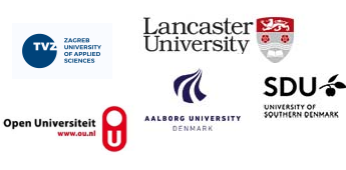

Bridging the gap between Networked Learning and Learning Analytics
Daria Kilinska, Thomas Ryberg & Frederik Victor Kobbelgaard
Aalborg University, Aalborg, Denmark
Intended Audience
The intended audience for this workshop is anyone, be that researchers or practitioners, who is interested in Networked Learning and/or Learning Analytics. Prior knowledge of methodologies used in the fields is preferred but not necessary. The most important trait is a curiosity towards influencing and, hopefully, furthering the practices of both fields.
Workshop Description
Learning Analytics is a field that is constantly evolving, encompassing new perspectives and expanding into other research fields. This workshop was inspired by the 2012 call for action from Rebecca Ferguson in which she called for building stronger connections to the learning sciences (Ferguson, 2012). Although this call has not remained unanswered, we still find this connection to be insufficient to foster the development of technological solutions needed in the future. This is where the Networked Learning community comes into play. During this workshop, we wish to discover, reflect on and build connections joining the two fields, in the hope that a better understanding of what Networked Learning can offer the Learning Analytics community and vice versa will foster beneficial and productive collaborations in the future. The workshop will comprise of three phases:
1. An introduction to the field of Learning Analytics and some of the historical challenges herein.
2. A session inspired by design thinking in which participants will go through four time boxed iterations:
3. A short wrap-up
Participant engagement
The participants will discuss the present and future perspectives for inter-collaboration between the fields of Learning Analytics and Networked Learning. This will be done through activities inspired by design thinking and the Double Diamond design model by Design Council UK (Design Council UK, n.d.). Four activities will be carried out:
1) Brainstorm
2) Mapping of ideas and inspirations to form inter-connectivity between the fields
3) Choosing and preparing insight for presentation
4) A brief presentation and discussion of chosen insights.
Participant outcomes
The intended outcome for the participants of the workshop is a further understanding of the interplay between the two fields. Furthermore, as the workshop is explorative in nature, it can be assumed that each participant might gain a better understanding as to strengths and weaknesses contained in each fields, and hopefully how an interplay between the fields can remedy weaknesses that exist.
The workshop alignment
The workshop connects to the following themes of the conference:
“Debates and emerging issues”. The field of Learning Analytics is developing rapidly, gaining more and more interest in different research communities. Despite this growing interest, there are voices that express a concern of whether consulting an even bigger dataset will give us answers that are scientifically and ethically sound. Through the workshop the participants will have a chance to discuss the doubts and challenges faced by the field of Learning Analytics and reflect upon what it means in relation to building connections between the fields of Learning Analytics and Networked Learning.
“Methods, research design, data and analysis in Networked Learning”. The workshop aims to investigate the possible connections between the fields of Networked Learning and Learning Analytics. The question that we aim to examine is how data about learners and their context can be used to understand and optimize environments based on Networked Learning principles, which directly aligns with the above theme.
Workshop process
1. Introduction (20 minutes) During the introduction, participants will be shortly introduced to some of the challenges that have been illuminated previously in the field of Learning Analytics. The intention of supplying this information is to inspire participants to relate the challenges to the field of Networked Learning whereby a connection occurs. Furthermore, a short introduction to the following session will be conducted.
2. Brainstorming session (60 minutes) During this phase, the participants will be divided into 2-4 teams depending on the number of participating conference goers. The teams will go through four timeboxed sessions, these are as follows:
a. Brainstorm (10 minutes) A short session in which ideas, characteristics of the fields, challenges for interplay and data features are brainstormed.
b. Ideation (20 minutes) During this session of 20 minutes, ideas from the brainstorming session will be clustered, organized and correlated to form ideas of possible points of inter-connectivity between the fields.
c. Preparation (10 minutes) During this session, the participants are to choose one idea that they wish to present, the presentation is then prepared.
d. Presentation (20 minutes) Each group has 3 minutes to present the chosen idea; this is followed by 2 minutes of immediate feedback by other groups.
3. Wrap-up (10 minutes) During the last ten minutes of the workshop, a short wrap-up will be performed with the intention of quickly summarizing emerged insights and relevant ideas that were not presented.
References
Design Council UK. (n.d.). What is the Double Diamond. Retrieved 4 October 2017, from: https://innovationenglish.sites.ku.dk/model/double-diamond-2/
Ferguson, R. (2012). Learning analytics: drivers, developments and challenges. International Journal of Technology Enhanced Learning, 4(5–6), 304–317. https://doi.org/10.1504/IJTEL.2012.051816
Joint Organising Institutions
Open University of The Netherlands
| Past Conference Proceedings | Contact |